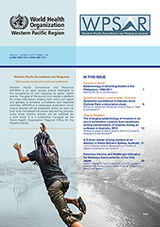Syndromic surveillance in Vanuatu since Cyclone Pam: a descriptive study
DOI:
https://doi.org/10.5365/wpsar.2016.7.3.009Abstract
In 2012, Vanuatu designed and implemented a syndromic surveillance system based on the guidelines developed by the Pacific Community and the World Health Organization to provide early warning of outbreaks and other important public health events. Four core syndromes were endorsed for surveillance: acute fever and rash, prolonged fever, influenza-like illness and acute watery diarrhoea. In March 2015, Vanuatu was struck by Cyclone Pam, after which several important changes and improvements to the country’s syndromic surveillance were made. To date, there has been no formal evaluation of whether regular reports are occurring or that core syndromes are being documented. We therefore carried out a descriptive study in the 11 sentinel sites in Vanuatu conducting syndromic surveillance between July and December 2015. There was a total of 53 822 consultations which were higher in the first 13 weeks (n = 29 622) compared with the last 13 weeks (n = 24 200). During the six months, there were no cases of acute fever and rash or prolonged fever. There were cases with influenza-like illness from week 27 to 35, but no case was reported after week 35. Acute watery diarrhoea occurred in one or two cases per week during the whole study period. For these two core syndromes, there were generally more females than males, and about one third were children aged under 5 years. In conclusion, Vanuatu implemented changes to its new syndromic surveillance system from July to December 2015, although laboratory components had not yet been incorporated. The laboratory components are working in 2016 and will be the subject of a further report.

